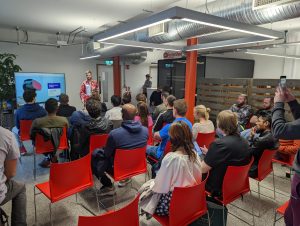If I invited you to the metaverse to spend some crypto on an NFT, would you even know where to begin? Or would you look at me with the most sideward glance you ever sideward-glanced?
To many, the third evolution of the web – or web3 as it’s commonly referred – is about as alien a concept as, well, actual aliens; it’s pie-in-the-sky, it’s out there, it’s unknown.
And yet, the interest in it is growing exponentially with every passing day. Statistics are difficult to pin down because the whole scene is still incredibly nascent – and yet some figures indicate that if it’s not an overwhelming trend just yet, it will be soon.
By way of illumination: according to some, by 2026, one in every four people will use the metaverse for an hour each day. That’s quite the prediction.
To those deeply invested (both literally and figuratively) in the world of web3, it’s easy to imagine why they might equate those of us who aren’t as people who still buy Blackberry’s in a world of iPhone 13 users.
There’s a great deal of scepticism around web3 right now, and a lot of that is because most of us don’t really understand that whole world. Some of it, though, is because many people have lost a lot of money through the likes of NFT scams. Per this Guardian piece, some $100 million worth of NFTs were stolen in the year-to-July thanks to hackers and scammers. That’s quite a significant amount of cash – and in an area often defined by its complexities, it’s something we can all wrap our heads around.
 The appetite is certainly there for it to continue growing. Indeed, on Thursday, August 25th, WebThreeIRL held an event at the PorterShed, Bowling Green, for anyone to understand more about ideas like Web3, the metaverse, NFTs, and more.
The appetite is certainly there for it to continue growing. Indeed, on Thursday, August 25th, WebThreeIRL held an event at the PorterShed, Bowling Green, for anyone to understand more about ideas like Web3, the metaverse, NFTs, and more.
A collective of founders, creatives, and interested parties gathered together to share their stories and perspectives on why web3 and all its inclusions interested them enough to get involved.
One of the speakers – Giovanni Gargiulo, CEO and co-founder of ArgusNFT – spoke about his company’s fight against fake or plagiarised NFTs through the use of machine learning. He talked about how his start-up is able to actually combat the rising trend through state-of-the-art technology, an effective and practical use-case in a sometimes hard-to-understand world.
Cormac Rowe, event organiser, told us: “It was fantastic to see such a massive turnout here this evening. You can tell that web3 isn’t just a phase; there are real people behind it all, and as much as I am fascinated by the metaverse, I loved seeing the community come together in person.”
Metadomo CTO, Robert O’ Shaughnessy, also spoke on the night about his journey in the world of web3, and he wasn’t afraid to urge people to remember that the whole industry is still very early days.
“If you see ‘web3 expert’ or ‘web3 guru’, take it with a pinch of salt,” Robert said.
Understandably, there is a great deal of cynicism around web3 right now, but it’s important to remember that we are still in the very nascent stages of it, and there is still so much for everyone to figure out, from the current problems to the future practicalities.
The WebThreeIRL event at the PorterShed was a fantastic crash course in many of the headlines, main questions, and interesting use-cases of web3, and it was interesting to hear so many passionate people attempt to untangle some of the complexities.
As Robert’s words attest, one thing that became most apparent was that web3 is still largely undefined, and the people in the thick of it are willing to accept that even they don’t have the answers yet. In a world – and at a time – where many like to pull the wool over each other’s eyes, that’s a refreshing stance to take; whatever your thoughts on web3, we could certainly do with more of that honesty.
By Trevor Murray

Content Marketing Specialist at the PorterShed
Email: trevor@portershed.com | LinkedIn | Twitter


